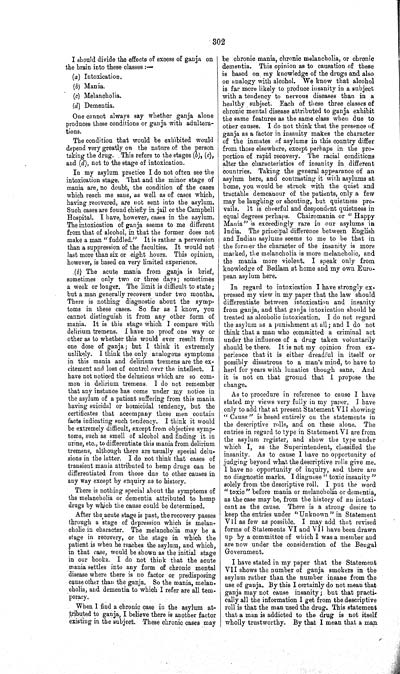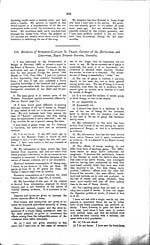Medicine - Drugs > Report of the Indian Hemp Drugs Commission, 1894-1895 > Volume IV
(316) Volume 4, Page 302
Thumbnail gallery: Grid view | List view

302
I should divide the
effects of excess of ganja on
the brain into these classes:—
(a) Intoxication.
(b) Mania.
(c) Melancholia.
(d) Dementia.
One cannot always say whether ganja alone
produces these conditions or ganja with adultera-
tions.
The condition that would be exhibited would
depend very greatly on the nature of the person
taking the drug. This refers to the stages (b),
(c),
and (d), not to the stage of
intoxication.
In my asylum practice I do not often see the
intoxication stage. That and the minor stage of
mania are, no doubt, the condition of the cases
which reach me sane, as well as of cases which,
having recovered, are not sent into the asylum.
Such cases are found chiefly in jail or the Campbell
Hospital. I have, however, cases in the asylum.
The intoxication of ganja seems to me different
from that of alcohol, in that the former does not
make a man "fuddled." It is rather a perversion
than a suppression of the faculties. It would not
last more than six or eight hours. This opinion,
however, is based on very limited
experience.
(b) The acute mania from ganja is brief,
sometimes only two or three days; sometimes
a week or longer. The limit is difficult to state;
but a man generally recovers under two months.
There is nothing diagnostic about the symp-
toms in these cases. So far as I know, you
cannot distinguish it from any other form of
mania. It is this stage which I compare with
delirium tremens. I have no proof one way or
other as to whether this would ever result from
one dose of ganja; but I think it extremely
unlikely. I think the only analogous symptoms
in this mania and delirium tremens are the ex-
citement and loss of control over the intellect. I
have not noticed the delusions which are so com-
mon in delirium tremens. I do not remember
that any instance has come under my notice in
the asylum of a patient suffering from this mania
having suicidal or homicidal tendency, but the
certificates that accompany these men contain
facts indicating such tendency. I think it would
be extremely difficult, except from objective symp-
toms, such as smell of alcohol and finding it in
urine, etc., to differentiate this mania from delirium
tremens, although there are usually special delu-
sions in the latter. I do not think that cases of
transient mania attributed to hemp drugs can be
differentiated from those due to other causes in
any way except by enquiry as to history.
There is nothing special about the symptoms of
the melancholia or dementia attributed to hemp
drugs by which the cause could be
determined.
After the acute stage is past, the recovery passes
through a stage of depression which is melan-
cholic in character. The melancholia may be a
stage in recovery, or the stage in which the
patient is when he reaches the asylum, and which,
in that case, would be shown as the initial stage
in our books. I do not think that the acute
mania settles into any form of chronic mental
disease where there is no factor or predisposing
cause other than the ganja. So the mania, melan-
cholia, and dementia to which I refer are all tem-
porary.
When I find a chronic case in the asylum at-
tributed to ganja, I believe there is another factor
existing in the subject. These chronic cases may
be chronic mania, chronic
melancholia, or chronic
dementia. This opinion as to causation of these
is based on my knowledge of the drugs and also
on analogy with alcohol. We know that alcohol
is far more likely to produce insanity in a subject
with a tendency to nervous diseases than in a
healthy subject. Each of these three classes of
chronic mental disease attributed to ganja exhibit
the same features as the same class when due to
other causes. I do not think that the presence of
ganja as a factor in insanity makes the character
of the inmates of asylums in this country differ
from those elsewhere, except perhaps in the pro-
portion of rapid recovery. The racial conditions
alter the characteristics of insanity in different
countries. Taking the general appearance of an
asylum here, and contrasting it with asylums at
home, you would be struck with the quiet and
tractable demeanour of the patients, only a few
may be laughing or shouting, but quietness pre-
vails. It is cheerful and despondent quietness in
equal degrees perhaps. Chairomania or "Happy
Mania" is exceedingly rare in our asylums in
India. The principal difference between English
and Indian asylums seems to me to be that in
the former the character of the insanity is more
marked, the melancholia is more melancholic, and
the mania more violent. I speak only from
knowledge of Bedlam at home and my own Euro-
pean asylum here.
In regard to intoxication I have strongly ex-
pressed my view in my paper that the law should
differentiate between intoxication and insanity
from ganja, and that ganja intoxication should be
treated as alcoholic intoxication. I do not regard
the asylum as a punishment at all; and I do not
think that a man who committed a criminal act
under the influence of a drug taken voluntarily
should be there. It is not my opinion from ex-
perience that it is either dreadful in itself or
possibly disastrous to a man's mind, to have to
herd for years with lunatics though sane. And
it is not on that ground that I propose the
change.
As to procedure in reference to cause I have
stated my views very fully in my paper. I have
only to add that at present Statement VII showing
"Cause" is based entirely on the statements in
the descriptive rolls, and on these alone. The
entries in regard to type in Statement VI are from
the asylum register, and show the type under
which I, as the Superintendent, classified the
insanity. As to cause I have no opportunity of
judging beyond what the descriptive rolls give me.
I have no opportunity of inquiry, and there are
no diagnostic marks. I diagnose "toxic insanity"
solely
from the descriptive roll. I put the word
"toxic" before mania or melancholia or dementia,
as the case may be, from the history of an intoxi-
cant as the cause. There is a strong desire to
keep the entries under "Unknown" in Statement
VII as few as possible. I may add that revised
forms of Statements VI and VII have been drawn
up by a committee of which I was a member and
are now under the consideration of the Bengal
Government.
I have stated in my paper that the Statement
VII shows the number of ganja smokers in the
asylum rather than the number insane from the
use of ganja. By this I certainly do not mean that
ganja may not cause insanity; but that practi-
cally all the information I get from the descriptive
roll is that the man used the drug. This statement
that a man is addicted to the drug is not itself
wholly trustworthy. By that I mean that a
man
Set display mode to: Large image | Zoom image | Transcription
Images and transcriptions on this page, including medium image downloads, may be used under the Creative Commons Attribution 4.0 International Licence unless otherwise stated. ![]()
| India Papers > Medicine - Drugs > Report of the Indian Hemp Drugs Commission, 1894-1895 > Volume IV > (316) Volume 4, Page 302 |
|---|
| Permanent URL | https://digital.nls.uk/74552882 |
|---|---|
| Description | Evidence of Bengal witnesses. |
| Description | Volume 4: Evidence of witnesses from Bengal and Assam. |
|---|---|
| Attribution and copyright: |
|




